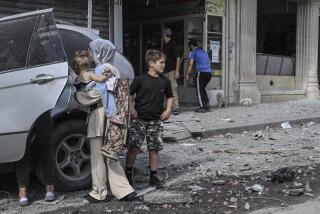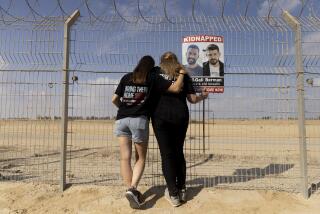It Ain’t Broke After All
- Share via
SOUTH POMFRET, Vt. — At first glance, the Iraq war appears to have produced a quick and efficient victory. On closer inspection, things look even better.
The military services and the defense industry, however, have already produced a grand new wish list of military hardware based on the war’s supposed “lessons.” We won’t face such an inept opponent again, they warn. Future wars will demand lighter vehicles, smarter weapons, stealthier fighters, longer-range missiles, better satellites, more communications bandwidth. In the longer term we must develop revolutionary new weapons employing lasers and high-powered microwaves and unmanned combat craft.
But a more basic lesson of this war is not that our military needs more but that our military should be at peace with itself. American firepower is overwhelming. The American military, far from being dysfunctional, is capable and flexible. And then there’s the matter of American weaponry.
With the dawn of the Cold War, America’s weapons focus changed dramatically. Planners feared that American conventional military forces were inadequate to stop a Warsaw Pact invasion of Western Europe, and so efforts and funds were poured into building thousands of nuclear weapons. Conventional weapons were given short shrift, as were less quantifiable facets of conventional military preparedness -- leadership, technology, inter-service coordination and training.
Iraq’s invasion of Kuwait in 1990 showed up the problems with America’s nuclear focus during the Cold War. Conventional firepower was now required, precision weapons were sorely needed and there was an urgent demand for better coordination among all the services. Special operations and intelligence needed to be better integrated into the war plan. Weapons put to the test for the first time were found to have significant shortcomings, like laser-guided bombs that tended not to work in bad weather.
The U.S. military was certainly up to the job, ejecting Hussein’s forces from Kuwait and declaring victory in 43 days. But after the war, planners quickly got to work solving the problems the fighting had highlighted.
The result? This time out, in just 21 days, with a force that many thought was too small, America decisively won the war. The mathematics of the victory, of the new firepower equation, is only beginning to emerge. Military aircraft flew 15,825 strike sorties and dropped 27,250 weapons. Coalition ground forces fired tens of thousands of artillery and mortar projectiles, rockets and tank-gun rounds.
In less than half the time of the 1991 Gulf War, with fewer than one-third of the strikes and with one-tenth the number of bombs, victory was achieved on the battlefield and the regime was overthrown.
And what happened to Iraq’s military -- to the infantry and the Republican Guards and the Special Republican Guards and the Fedayeen Saddam? Firepower happened. By Day 2 of the war, U.S. planes were flying as many as 1,000 strikes against Iraqi ground forces.
But what was especially new was that the integration of all services and of intelligence, together with all of the advantages of the information age, gave each of those bombs unprecedented bang. “It’s just awesome the number of tanks, APCs [armored personnel carriers], track vehicles and enemy positions that were attacked,” one Air Force wing commander told the Chicago Tribune.
Air attacks on Iraqi forces were quickly followed by rapid Army and Marine advances that overwhelmed defenders. By the time it was all over, Pentagon Comptroller Dov Zakheim estimated at an April 16 press conference, U.S. forces had exploded an estimated $3 billion worth of bombs, bullets, missiles, shells, rockets and mortars.
Those who proselytize for a military “transformation” say the Iraq war proves the value of speed and agility for U.S. forces. In the future, they suggest, slow and heavy needs to make way for sleek and light.
But the lessons of Iraq suggest that calls for wholesale transformation of the military may be overkill. As the war demonstrated, the “delivery platforms” behind the firepower -- the planes, the tanks, the guns themselves -- can’t be evaluated in isolation but must be considered in the context of the weapons they are firing.
Take the case of the large and seemingly obsolete B-1 bomber. Secretary of Defense Donald H. Rumsfeld announced soon after taking office that, as a step toward military transformation, the B-1, a nuclear-era bomber employed in conventional combat for the first time in December 1998, would be retired.
But then 9/11 happened, and the B-1 began to be used extensively in combat. The plane performed superbly in both Afghanistan and Iraq. A B-1 packed with weapons was used to attack a suspected meeting at a restaurant of Saddam Hussein and the Iraqi leadership in western Baghdad on April 7. Not only did it drop four satellite-guided weapons on the restaurant in two separate strikes, it went on to attack, during the same mission, 15 additional targets: six in the Iraqi capital and nine in Tikrit.
In 432 strikes during the war, B-1s delivered more than 2,250 tons of bombs. The B-1s, together with a handful of ancient, lumbering B-52s, dropped more than two-thirds of all the bombs dropped in Iraq.
The old-fashioned, nearly 70-ton Abrams tank is the ground-based equivalent of the bombers. Whatever these tanks lack in agility and speed they more than make up in presence and firepower -- as they proved in the war. Transformation advocates tout a new fast-moving “Stryker” wheeled vehicle to supplant the tank, but such a vehicle will never have the physical and psychological profile of an Abrams rumbling over a hill or down a city street.
So if our weapons and equipment are effective, does nothing need improving? When compared to Hussein’s military, which was crippled by oppressive centralization and poor training, the U.S. military seems like a big, happy family. But much work still needs to be done before its separate institutions learn to love fighting “jointly” together.
One report circulating about this war is about how Army units went solo in some of their initial forays, not telling air forces what they were up to and thus denying themselves air support. In one of those strikes near Karbala on March 24, 27 of 34 Apache attack helicopters sent out on a single mission against the Republican Guard’s Medina Division returned so damaged they could no longer fly. One Apache was shot down, and two Army warrant officers were taken prisoner. It all might have been avoided with better ground/air coordination.
We have the firepower we need, and we have the well-trained forces. In general they work well together. But out of this war we need to gain a better appreciation of the combined effects of all of our firepower. Not only are we in need of accurate information about exactly what was unleashed by U.S. and coalition forces; we also need to press the best military minds to change the standards by which we measure our military capability and the capabilities of our opponents. We need to appreciate what we’ve got.
During the Cold War, weapons of mass destruction in the hands of unfriendly regimes threatened U.S. military might and sparked an unprecedented arms race. Now, as the Iraq war demonstrated, we have some breathing space. The U.S. has proved itself so superior in fighting capability and so little threatened that it can rest a bit on its laurels.
More to Read
Sign up for Essential California
The most important California stories and recommendations in your inbox every morning.
You may occasionally receive promotional content from the Los Angeles Times.










